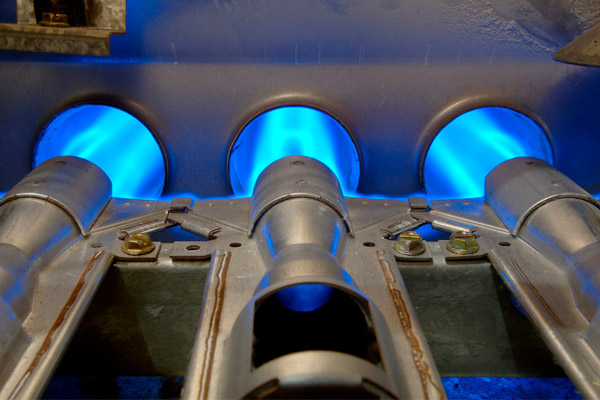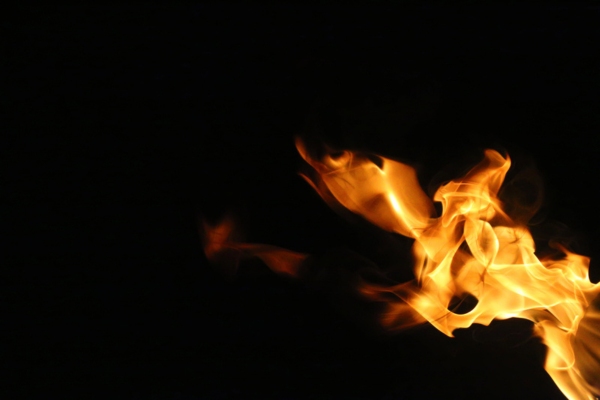Warning Signs Of A Cracked Heat Exchanger In Your Gas Furnace
Updated: 11/04/2024

Maintaining and regularly inspecting your home’s heating system is critical for optimal performance and safety. One critical issue that requires immediate attention is a cracked heat exchanger in your gas furnace. Such damage leads to decreased efficiency and poses serious safety risks.
The gas furnace heat exchanger plays a pivotal role by transferring heat from the combustion gases to the air circulating through your home. Understanding this function is critical to recognizing the importance of its integrity for your system’s efficiency and safety.
When a heat exchanger is damaged, you will notice various signs, including unusual noises, reduced heating efficiency, soot accumulation inside the furnace, or a distinct smell similar to formaldehyde. Being aware of these indicators allows you to take swift action to maintain the safety and performance of your heating system, ensuring your home stays comfortable and safe. Keep reading this article from Miller Oil Company to learn more!
Understanding the Gas Furnace Heat Exchanger
Contents
- 1 Understanding the Gas Furnace Heat Exchanger
- 2 Indicators Your Furnace Has A Heat Exchanger That’s Cracked
- 3 Causes of Furnace Heat Exchanger Damage
- 4 Risks of a Cracked Gas Furnace Heat Exchanger
- 5 Addressing a Broken Furnace Heat Exchanger
- 6 Cracked Heat Exchanger FAQs
- 6.1 How Long Does a Furnace Heat Exchanger Typically Last?
- 6.2 How Can You Tell If a Heat Exchanger Is Nearing Its Lifespan Limit?
- 6.3 How Frequently Should a Heat Exchanger Be Professionally Inspected?
- 6.4 Can a Carbon Monoxide Detector Identify Issues with a Heat Exchanger?
- 6.5 Do Environmental Benefits Result from Proper Heat Exchanger Maintenance?
- 7 Conclusion
- 8 Call Miller Oil Company for Top-Notch HVAC Services

A heat exchanger is an essential component within any heating system. It transfers heat between fluids to help maintain the temperature within a home or building. In residential heating systems, the heat exchanger primarily functions by warming the air that moves through the ventilation system.
The heating process in your furnace begins with igniting combustible gas, which significantly raises the system’s temperature. This heated gas collects in the heat exchanger, where it efficiently transfers heat to the air flowing through the system. This mechanism is crucial for delivering warm air throughout your home.
A crack in the heat exchanger can severely disrupt this process. It leads to decreased heating efficiency by allowing heat to escape and poses significant safety risks through the potential leakage of combustion gases. It’s essential to promptly identify and resolve any issues with the heat exchanger to maintain the efficiency and safety of your heating system.
Prioritize Safety: Ensure your heating system’s safety and efficiency by trusting Miller Oil Company for expert inspections. Protect your home from potential hazards by scheduling a comprehensive safety check today.
Indicators Your Furnace Has A Heat Exchanger That’s Cracked
Look out for symptoms that could indicate a cracked heat exchanger in your furnace, including:
Changes in the Furnace Flame

A vital indicator of a healthy gas furnace is a steady blue flame, which signifies complete and efficient combustion. This blue flame indicates that the gas is fully utilized to generate heat, ensuring safe and efficient operation.
A shift in the furnace flame’s color from blue to yellow is a critical warning sign of potential issues. This yellow discoloration often indicates that the burner might be dirty or obstructed by debris, which can interfere with combustion.
More critically, a yellow flame could also signify a cracked heat exchanger. This severe condition allows combustion gases to mix with the circulating air, potentially creating hazardous situations within your home. Immediate inspection and repair ensure safety and restore proper furnace operation.
An unstable or flickering flame in your furnace clearly indicates trouble, often related to airflow disturbances or other malfunctions within the unit. These disruptions can compromise the efficiency and safety of your heating system. It’s crucial to address these signs promptly by consulting with a professional. Ensuring timely maintenance and repairs can help keep your heating system operating safely and efficiently.
Keep Your System Optimal: Trust Miller Oil Company to uphold the efficiency of your heating system. Secure peak performance by scheduling a maintenance appointment today!
Soot Buildup in Your Furnace
Soot accumulation inside your furnace is typically a sign of incomplete combustion, resulting in unwanted carbon buildup. This issue often stems from a cracked heat exchanger or an improperly adjusted burner, preventing the fuel from burning completely and cleanly. Regular inspections and maintenance identify and rectify these problems, ensuring your furnace operates efficiently and safely.
Corrosion & Cracks On Your Heating System’s Components
Regularly examine your home heating system’s external components for signs of rust and cracks. The appearance of such damage on the outside can often hint at similar, more severe issues with the internal components. This visible deterioration may indicate extensive damage requiring professional evaluation and repair to ensure the system’s integrity and safety.
Unusual Odors from Your Furnace

If you detect a distinct and unpleasant odor similar to formaldehyde from your furnace, it could indicate a cracked heat exchanger. This smell is not just a nuisance; it can be harmful, potentially causing severe headaches and other health issues.
Such conditions require urgent attention. Contacting a professional HVAC technician is crucial if you notice this unusual odor. Quick action is necessary to inspect and repair your heating system, preventing further damage and safeguarding the health and safety of your household.
Health Risks from Furnace Malfunctions
Carbon monoxide leakage from a malfunctioning furnace can cause a range of health symptoms that may mimic flu-like conditions, such as sleepiness, disorientation, nausea, and irritation of the eyes and nose. These symptoms often become apparent or worsen when individuals are at home, indicating an indoor source of exposure.
Recognizing the signs of carbon monoxide poisoning is crucial, as it is a severe and potentially fatal condition if not promptly addressed. Immediate actions, such as ventilating the area and evacuating if necessary, are vital for safety.
Installing and regularly maintaining carbon monoxide detectors in your home, particularly near sleeping areas, is essential to prevent such dangers. Moreover, ensuring that your furnace undergoes regular inspections and maintenance by a qualified professional is crucial in safeguarding against the risks of carbon monoxide exposure.
Avoid Issues: Choose Miller Oil Company for comprehensive inspections of your heating system. Stay proactive against potential problems with our expert evaluation services. Contact us today to schedule your inspection!
Causes of Furnace Heat Exchanger Damage
Heat exchanger cracks often originate from overheating, typically caused by insufficient airflow. This problem is frequently linked to neglect in maintenance. Over time, accumulations of dirt, dust, and other pollutants can lead to clogged filters, coils, and blowers, which restrict airflow.
Adequate airflow is crucial for maintaining optimal internal temperatures and dissipating excess heat. Without proper airflow, the system’s internal temperature escalates, significantly heightening the risk of cracks in the heat exchanger.
Moreover, cracks can also develop due to wear and tear on control valves. As these valves age, they may cause pressure fluctuations that the heat exchanger is not designed to withstand.
Regular and thorough inspections of your heating system are vital to identify these and other potential problems early. Preventative maintenance is key to reducing risks, prolonging the lifespan of your system, and ensuring it operates safely and efficiently.
Risks of a Cracked Gas Furnace Heat Exchanger

A cracked heat exchanger poses serious risks far beyond simple inconveniences. It’s a significant hazard to your home and personal safety. Many heating systems use propane, fuel oil, or natural gas, all of which are fossil fuels. When burned, these fuels emit fumes that include water vapor, soot, carbon dioxide, and, notably, carbon monoxide—an odorless, colorless, but highly toxic gas.
A compromised heat exchanger can increase the emission of harmful gases, particularly carbon monoxide. Extended exposure to high levels of these gases can result in severe health issues for residents. This situation highlights the urgency of immediate intervention and repair to secure safety and ensure healthy indoor air quality in your home.
Safeguard Your Comfort: Depend on Miller Oil Company for expert services that ensure your heating system operates reliably and efficiently. Keep your home warm and secure by contacting us today for immediate assistance!
Addressing a Broken Furnace Heat Exchanger
If you detect a potentially damaged heat exchanger in your heating system, avoid attempting to inspect or repair it yourself due to the significant safety risks involved, including the danger of exposure to harmful gases like carbon monoxide. Typically, the resolution involves replacing the compromised component or, in more severe cases, the entire heating system. Such decisions require expert analysis and precision.
It is essential to engage a certified heating technician to perform a comprehensive inspection and testing of your system to pinpoint the exact cause of the issue. The technician will recommend the best course of action, whether repair or replacement. They will also guide you on proper maintenance practices to ensure safety and efficiency. This professional advice is crucial to prolonging the life of your heating system and averting future complications.
Cracked Heat Exchanger FAQs

How Long Does a Furnace Heat Exchanger Typically Last?
The longevity of a heat exchanger depends on several factors, including the type of heating system, the quality of its installation, and how frequently it is maintained. Generally, a well-maintained heat exchanger in a residential furnace is expected to last between 15 to 20 years.
How Can You Tell If a Heat Exchanger Is Nearing Its Lifespan Limit?
Several signs may become evident when a heat exchanger is nearing the end of its service life. You might notice an unexpected increase in heating bills despite consistent usage patterns, frequent system breakdowns, and an increased frequency of necessary repairs. These issues often indicate that the heat exchanger, and potentially other parts of the heating system, are wearing out and may soon need replacement to ensure continued efficiency and safety.
How Frequently Should a Heat Exchanger Be Professionally Inspected?
It is advisable to have a professional inspect your heat exchanger annually, ideally before the onset of the heating season. Regular inspections help confirm that the heat exchanger is operating correctly and safely, free from any issues that could pose safety hazards.
Safeguard Your Home: Choose Miller Oil Company for thorough inspections and repairs of your heating system. Shield your household from potential risks by scheduling your inspection today!
Can a Carbon Monoxide Detector Identify Issues with a Heat Exchanger?
Yes, installing a carbon monoxide detector is an effective way to receive early warnings about a cracked heat exchanger or other malfunctions that might cause carbon monoxide leaks. This device is an essential safety tool in any home that uses fuel-burning appliances, helping prevent potential hazards and ensure residents’ well-being.
Do Environmental Benefits Result from Proper Heat Exchanger Maintenance?
Properly maintaining a heat exchanger yields environmental benefits. Efficient operation and safety aside, a well-maintained system optimizes fuel usage, which minimizes wasteful energy consumption and reduces the emission of harmful pollutants. This helps conserve natural resources and supports a healthier environment by decreasing the overall ecological footprint of your home heating system.
Conclusion
A cracked heat exchanger compromises your heating system’s integrity and household safety. However, these issues are preventable with regular maintenance and care, ensuring the heat exchanger functions effectively for years.
If you observe any signs of a problem or have concerns, contact your local HVAC contractor immediately. Discussing potential solutions and preventative strategies with a professional can significantly extend your system’s lifespan and improve its safety and efficiency. Remember, consistent maintenance is crucial for optimal performance and longevity.
Enhance Efficiency: Trust Miller Oil Company for expert heating system services. Ensure your system performs optimally by booking an appointment with us today!
Call Miller Oil Company for Top-Notch HVAC Services
Miller Oil Company offers exceptional heating and cooling services throughout the Greater Enfield, Connecticut area, featuring a team of professionally certified technicians known for their expertise. Whether you need HVAC tune-ups, repairs, installations, or replacements, our technicians apply their extensive knowledge and experience to ensure your system gets the comprehensive care it deserves.
At Miller Oil Company, we pride ourselves on providing competitively priced services, offering the best value for heating and cooling solutions. Our maintenance services help boost your comfort and enhance your home’s energy efficiency, reducing heating and cooling expenses. If you need HVAC repair or are considering a new system installation, we provide tailored recommendations to suit your home and budget perfectly. We back our services with a satisfaction guarantee.
Call Miller Oil Company today for a free in-home consultation and to discover the Miller Oil Company difference!
To schedule a service appointment, contact Miller Oil Company today. We also offer free, in-home estimates. Click the link to view our service area.

Related Articles: